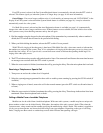Conventional Operation
With conventional operation, selecting a system actually selects a specific radio channel. Then selecting a group (if
available) selects the mobile or group of mobiles being called or from which calls are received on that channel. There
are no tones or display messages to indicate busy or out-of-range conditions. Therefore, a busy channel must be
detected as described in the next section, and an out-of-range condition may exist if you are unable to get a response
from the mobile you are calling.
Conventional Monitoring Before Transmitting
Before transmitting in the conventional mode, government regulations require that you monitor the channel before
transmitting to make sure that it is not being used by someone else. If you were to transmit while someone else was
talking, you would probably disrupt their conversation.
If the Transmit Disable On Busy feature is programmed (see description on page 16), monitoring is performed
automatically. If it is not used, monitoring is performed as follows:
• When not system or group scanning, note if “BUSY” is being displayed. If it is not, the channel is free and a
message can be sent.
• Enable the monitor mode by taking the microphone off-hook or pressing the MON switch if available. The
monitor mode is indicated by “MON” in display, and it disables any programmed squelch control features so that
all messages are heard. It also halts scanning if applicable.
• If equipped with the CG option switch, both transmit and receive Call Guard squelch or other squelch control
features can be disabled on the selected group only. The disable mode is indicated by a triangle (
∆ ) in the display
under the switch.
The transceiver can also be programmed so that a microphone off-hook condition is not detected. The Transmit
Disable On Busy feature or MON/CG switches must then be used to perform monitoring.
GENERAL FEATURES
NOTE: The following features are available with all three types of operation (Multi-Net, LTR, and conventional).
Time-Out Timer
The Time-Out Timer automatically disables the transmitter if it is keyed continuously for longer than the
programmed time. It is usually programmed by your system operator for 0.5-5 minutes. When this timer times out, the
transmitter is automatically disabled, the intercept tone sounds, and “TX TIMEOUT” is displayed.
Five seconds before time-out occurs, a warning beep sounds. The timer is reset by releasing the PTT switch. One
use of this feature is to prevent a blocked channel caused by an accidentally keyed transmitter. Another use is to prevent
possible transmitter damage caused by transmitting for extended periods.
Call Indicator
The call indicator is the word “CALL” in the display. The purpose of this indicator is to show when a call is
received while you were away from the vehicle. It can be programmed by your system operator to come on only when
calls are received on specific groups. To turn this indicator off, change any front panel control, take the microphone off-
hook, press the PTT switch, or turn power off and then on again.


















